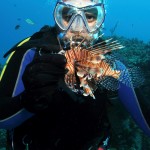Fisheries Research
The AHF is embarking on a number of important fisheries research programmes to inform and improve how we manage fisheries resources within the East Portland Fish Sanctuary and across Jamaica. This includes the management, ecology and control of invasive species; monitoring and assessment of vulnerable species; spatial monitoring and migration patterns; fish spawning aggregations and monitoring of bio-indicators to inform management.
Lionfish Control and Management
The invasion of the Indo Pacific lionfish has presented a serious threat to local fisheries. Introduced through the aquarium trade, the lionfish has crossed natural barriers and has now invaded the Caribbean Region. The lack of natural predators and its high egg production has facilitated the growth of thriving populations throughout the Caribbean, Gulf of Mexico and off America’s Atlantic coast that can now be found in all types of marine environments. Research has shown the lionfish to consume over 27 different fish and shellfish species, presenting a serious threat to Jamaica’s already dwindling fisheries resources.
Over the past 4 years, The UWI has led a project to control the lionfish using adaptive research and management strategies. This has seen much success, with some sites currently showing a 75% decrease in lionfish densities when compared with 2009. A large part of this success is the multi-entity approach of public and private sector groups across the island in removal of the lionfish from these waters.
Based on the most recent survey conducted in Portland, there is need for more focussed attention on the San San area, especially the reef surrounding Alligator Head. This area is a vibrant fishing area with several important commercial species present, which support the coastal communities in Portland. A long-term monitoring program, a coordinated sustained removal program and a public awareness program are needed to control this species within this area. A comprehensive training program is required initially to build capacity in the area to fuel these programs.
Baited Remote Underwater Videocameras (BRUV) Research
The AHF has partnered with Stony Brook University and Florida International University (FIU) as part of the Global Finprint Programme – an initiative that brings together an international research team and collaborators around the world to fill a critical information gap about the diminishing number of sharks and rays (elasmobranchs). The research will improve our understanding of how elasmobranchs influence the coral reef ecosystem and how humans impact these species and their habitats. Having Jamaica represented as part of this research, will aid management and conservation efforts for marine life in Jamaica.
The study included deploying a series of Baited Remote Underwater Video Cameras (BRUVs) at sites in Negril, Discovery Bay, Ocho Rios, Portland and Pedro Cays.The results show that large predators were rare along the north coast however one juvenile tiger shark was observed in Negril. The offshore banks of Pedro Cays showed a number of nurse, reef, blacknose and tiger sharks indicating that shark biodiversity hotspots still exist in Jamaica and that there is a need to protect and effectively manage these areas. AHF has secured 3 BRUVs through an agreement with FIU to continue this critical research and deploy BRUVs on a regular basis in the EPFS, as well as at other sites within the Jamaica Fish Sanctuary Network.

